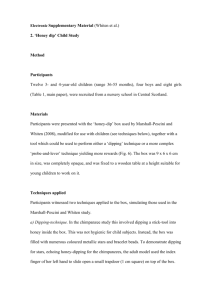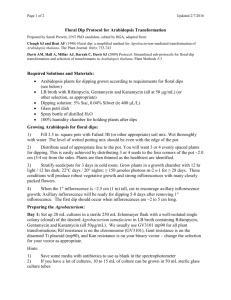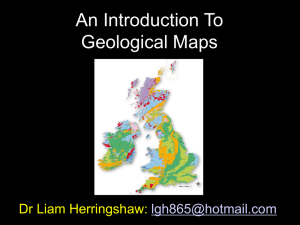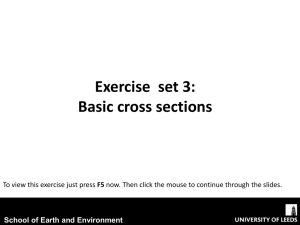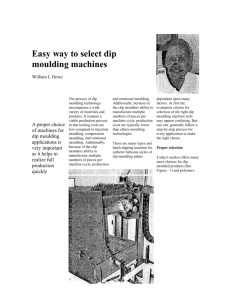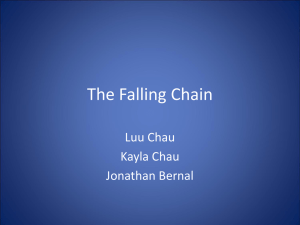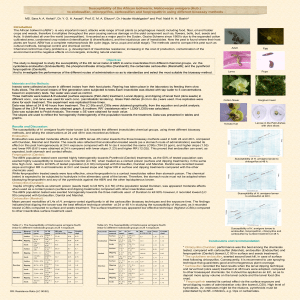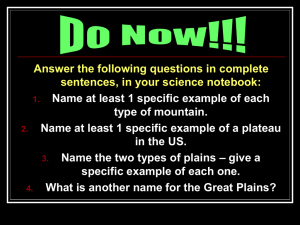Cross sections of folded and dipping beds
advertisement
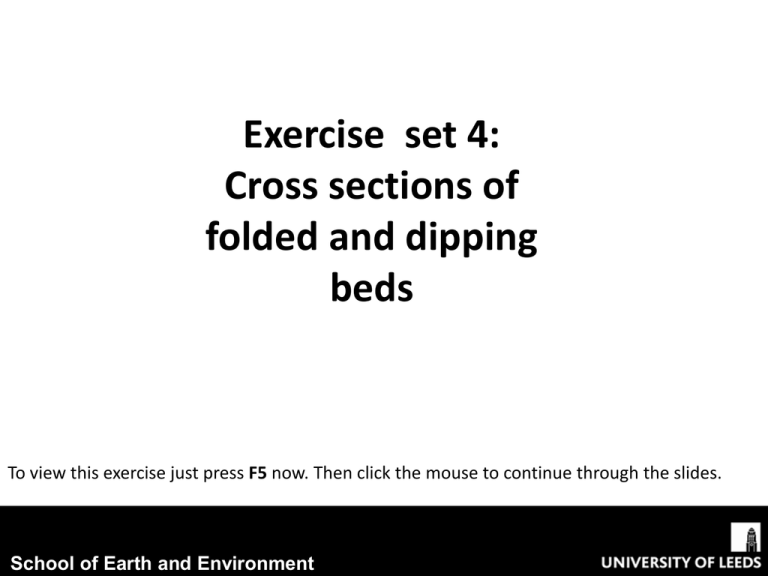
Exercise set 4: Cross sections of folded and dipping beds To view this exercise just press F5 now. Then click the mouse to continue through the slides. School of Earth and Environment Folded and dipping cross sections • This presentation is to be completed in conjunction with exercise worksheet 4. Objectives: • By the end of this exercise you should: • Be able to construct cross sections of dipping beds. • Be able to construct cross sections of folded beds. • This exercise will build on many of the concepts you have learnt so far, utilising: • Folded structures. • Law of “V’s”. • Drawing cross sections. • Calculating true thickness. School of Earth and Environment Folded and dipping cross sections: Problems • As we have previously covered the techniques necessary to complete these exercises, we will move straight onto problems instead of going through an example. • Using exercise worksheet 4, attempt problem 1 before continuing onto the next slide. • Questions for problem 1: a) Look at the outcrop pattern and deduce the direction of dip. Which is the oldest bed and which is the youngest? b) Draw structure contours for each geological interface and calculate the strike and amount of dip from a representative area of the map. c) Draw a cross section from A to B assuming constant dip. School of Earth and Environment Folded and dipping cross sections: Problems Answers for problem 1: a) Following the law of “V’s” that: Beds dipping downstream V-downstream ; the beds must dip to the South. Then following the law of superposition stating that: “In any un-overturned sequence of rocks deposited in layers, the youngest layer is on top and the oldest on the bottom; each layer being younger than the one beneath it and older than the one above” Then the series of deposition must be: Folded and dipping cross sections: Problems Answers for problem 1: b) Remember: to draw structure contours, the geological boundary is known where it crosses a topographic contour line. For example a line can be drawn through the four geological boundaries where they cross the 600m contour. Then use a protractor to measure strike; Strike = 85o School of Earth and Environment Folded and dipping cross sections: Problems Answers for problem 1: b) Then to calculate dip, choose two representative structure contours, eg. 400m and 500m. Using your ruler measure the distance between these on the map (250m), this gives you the adjacent length of the triangle (see below). Then calculate the difference in height from the structure contours (100m) , this gives you the opposite side of the triangle. Then using simple trigonometry: tan(θ) = (opp/adj) tan(θ) = (100m/250m) tan-1(100m/250m) = θ = 22° True dip = 22° School of Earth and Environment Folded and dipping cross sections: Problems Answers for problem 1: c) First mark on the topographic points. School of Earth and Environment Folded and dipping cross sections: Problems Answers for problem 1: c) Then mark on the geological interface points. School of Earth and Environment Folded and dipping cross sections: Problems Answers for problem 1: c) Then using a protractor, measure a dip of 22o and draw on the dipping beds. School of Earth and Environment Folded and dipping cross sections: Problems Answers for problem 1: c) Now fill in the beds lithological patterns. School of Earth and Environment Folded and dipping cross sections: Problems Answers for problem 1: c) Finally extend the structure contours, to show where the beds would extend to if they hadn’t been eroded. School of Earth and Environment Folded and dipping cross sections: Problems • Using exercise worksheet 4, complete problem 2 before continuing onto the next slide. • Questions for problem 2: a) On the map draw structure contours for each boundary (i.e. SiltstoneShale boundary; Shale-Grit boundary). b) Calculate the true thickness of the shale bed. c) Using the topographic and structure contours, construct a cross section through A to B. d) Indicate on the map the position of an anticlinal axis with the symbol: and a synclinal axis with the symbol: School of Earth and Environment Folded and dipping cross sections: Problems Answers for problem 2: a) Remember: to draw structure contours, the geological boundary is known where it crosses a topographic contour line. Blue = Siltstone-shale boundaries; Green = Grit-shale boundaries School of Earth and Environment Folded and dipping cross sections: Problems Answers for problem 2: b) Remember to calculate true thickness: True thickness (t) = width of outcrop (w) x sin(θ) (angle of dip) So first we must calculate the angle of dip using structure contours (e.g. the most Westerly shale structure contours: 700m and 600m.) The distance between these is: ~9mm = 180m. The difference in height is: 700m-600m = 100m Therefore: tan(θ) = (opp/adj) tan(θ) = (100m/180m) tan-1(100m/180m) = θ = 29° True dip = 29° So: True thickness (t) = 370m x sin(29°) True thickness (t) = 179 m School of Earth and Environment Folded and dipping cross sections: Problems Answers for problem 2: c) First mark on the topographic points. School of Earth and Environment Folded and dipping cross sections: Problems Answers for problem 2: c) Then mark on the lithological interfaces. School of Earth and Environment Folded and dipping cross sections: Problems Answers for problem 2: c) Then assuming constant dip, structure contour points from other areas of the map can be added to this. School of Earth and Environment Folded and dipping cross sections: Problems Answers for problem 2: c) Now the beds can be drawn on. Remember to use solid lines where the actual boundaries are and dotted lines for where the boundaries are unknown as well as where they would of extended to above ground level prior to erosion. How does the measured thickness of the cross section compare with your calculated actual thickness? School of Earth and Environment Folded and dipping cross sections: Problems Answers for problem 2: d) Now you have drawn the cross section you can place the axis on the folds. School of Earth and Environment Summary We have now worked through how to: • Construct cross sections of dipping beds. • Construct cross sections of folded beds using structural contour points. School of Earth and Environment
